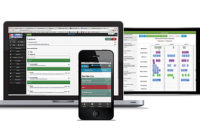
Many software companies are providing contractors new ways to streamline their in-home sales, back-office management, and diverse field operations. (Photo courtesy of Wrightsoft.)
Contractors have always used a lot of hardware to make their companies successful. Tools, trucks, HVAC units, filters, and IAQ products are just a few of the items contributing to an HVAC business’ daily routine.
As times change, contractors have begun to implement a new piece of hardware that has helped revolutionize the way business is done - a computer. This revolutionary piece of hardware, however, is useless without the software applications designed to meet the specific needs of the HVAC industry.
BACK OFFICE ORGANIZATION
Software companies have created diverse applications to help the contractor run a successful and efficient business. These new tools of the trade endeavor to save time and money for both the contractor and the technician. They also improve accuracy, tracking, and data collection, yielding more reliable sources of valid information that can be viewed and used efficiently.One such company offering this is Shift Schedules in Meridian, Idaho. Using Excel spreadsheets, Shift Schedules has created hundreds of templates for tracking weekly shift, daily task, and training history schedules. “We have eight-, 10-, and 12-hour templates for one, two, or three shifts a day for a five-, six-, or seven-day work week,” said the company. “Our spreadsheets can schedule people to rotating shifts, fixed shifts, or split shifts as well.”
The newest feature from Shift Schedules is its employee training history spreadsheet. Using this template, contractors have the ability to enter training information on each employee and then use the information to create specific reports. The records can be filtered to display only records of interest related to the type, location, instructor, dates of training, etc. Training histories for the individual can also be generated and printed, or sent automatically via e-mail.
Keeping track of shift schedules and training aren’t the only benefits provided via software. Some software programs actually assist technicians in performing their daily tasks. Insparisk, parent company of City Spec Inc., Glendale, N.Y., has designed Versentia™, a suite of software solutions for the safety inspection industry, to fit multiple applications. The first application, boiler inspection, manages inspections and client data in the boiler industry and combines customized routing and inspection functionality. The boiler program enables inspections to be filed electronically as well as tracked and catalogued with digital photographs. Once the information is loaded into the software system, it is accessible online via the Internet.
“The process is done all electronically, there is no paper mess,” said Stephen Kleva, president and CEO of Insparisk. “The program is automatic and ever checking. There are less data entry errors than with paper, and it reduces the amount of office staff required, reducing internal costs.”
The company has begun development on elevator and building facade applications as well, with fire detection/suppression systems and electrical panel applications being planned. According to Kleva, the HVAC equipment application is currently being tested and is scheduled to have a demo version of the software released later this year.
“We see a huge opportunity in automating safety inspection in a variety of markets, many of which still function with pen and paper,” said Kleva. “The increased accuracy and efficiency enabled by Versentia greatly benefits those who use the program.”
FIELD SYSTEM CHECK
Software that helps provide office management and cost reduction are invaluable, but contractors are also in need of software solutions outside of the office. Xora Inc., based in Mountain View, Calif., offers a mobile resource management application that enables contractors to track and manage field staff via GPS-enabled mobile phones.Del-Air Heating, Air Conditioning & Refrigeration Inc. in Sanford, Fla., implemented the Xora GPS TimeTrack™ program for workers in Jan. 2004, and according to the company, has since seen incredible money-saving results. Del-Air field technicians carry the phones to clock in and out each day. They also use Xora’s Job Module to record start and stop times for various projects and the status of each job. The real-time data captured in the field is then sent to Xora servers where Del-Air supervisors can view Web-based maps and reports. Using the program, the company eliminated paper-based timesheet reporting and manual data entry. It also enhanced its mobile worker location tracking, which, Del-Air reports, led to improved efficiency.
According to the company, in the first year Del-Air saved more than $350,000 from implementing Xora, based strictly on the automated time cards capability. The company also expects to save another $30,000 from reduced data entry.
Xora also offers GPS TimeTrack™ for Vehicles and GPS AssetTrack™.

Wrightsoft’s Right-Suite™ Universal combines the previously separate Right-Suite Residential and Right-Suite Commercial products and incorporates the company’s latest proprietary technologies into a single, modular product. (Photo courtesy of Wrightsoft.)
TIME-SAVING ACCURACY
Basic office and field management software are helpful to the HVAC contractor and technician. Determining proper equipment sizes, generating a system design with parts takeoff, and preparing proposals and in-home sales presentations, however, can also be challenging and time-consuming.Released in October 2007, Wrightsoft Right-Suite™ Universal combines the previously separate Right-Suite Residential and Right-Suite Commercial products and incorporates Wrightsoft’s latest proprietary technologies into a single, modular product.
Right-Suite Universal includes 15 total modules for residential and commercial load calculations, standard and high-velocity duct sizing and layouts, radiant heating layouts, geothermal loop calculations, bill of materials generation, proposals, and in-home sales presentation and management tools. Some of the new features and capabilities contractors can take advantage of are multi-level and multi-equipment zoning, improved duct layout techniques, built-in tutorial and help videos, and line-by-line edits and discounts in the bill of materials, to name a few.
For residential or commercial new construction applications, the Right-Draw® module still forms the foundation of the program, acting as a single data entry point to determine load calculations using the Air Conditioning Contractors of America (ACCA) Manual J; American Society of Heating, Refrigerating and Air-Conditioning Engineers (ASHRAE) cooling load, temperature difference (CLTD) or radiant time series (RTS); or the Heating, Refrigeration, and Air Conditioning Institute of Canada (HRAI) methods, and generate a full ACCA Manual D or ASHRAE duct, high-velocity or radiant system layout with a project estimate and parts takeoff. This is possible because of Wrightsoft’s Hotlink Technology™ that connects all of the modules so a change made in one area or module of the program, automatically updates all the other areas.
HVAC designers are also able to import CAD files to the software’s draw screen and use them as a guide during the project. They can then write their two-line, CAD-quality duct and radiant designs back to the CAD files, providing paperless communication.
Contractors not only have to design systems, but they also have to sell the systems that they have designed. “For in-home sales and replacement applications, the Right-Sales® module, as part of Right-Suite Universal, can increase professionalism, and set a contractor’s business apart from the competition, helping to increase referrals and sales,” said the company.
According to Wrightsoft, using just the Right-J®, Right-Draw, Right-$™, and Right-Sales modules, it is possible for a contractor to go into a customer’s home and do a complete in-home sales presentation, including an ACCA-certified Manual J block load calculation, equipment comparison, and operating cost analysis. These modules provide contractors with on-the-spot estimates and a ready-to print custom proposal, in order to achieve higher close ratios and a one-call close.
“Buying and using Wrightsoft software is one of the smartest decisions I’ve ever made for my business,” said Bob Quierolo Jr., president of B&B Heating and Air Conditioning Inc. “My close ratio used to be about 50 percent, but now I’m at 75 percent, and it’s getting higher all the time.”
Publication date:02/25/2008




